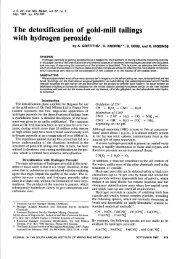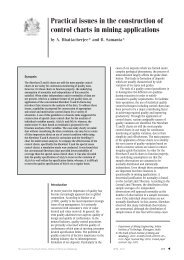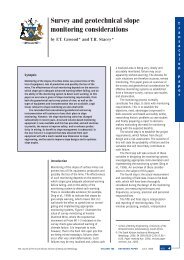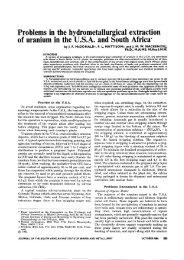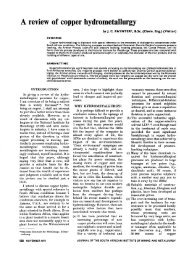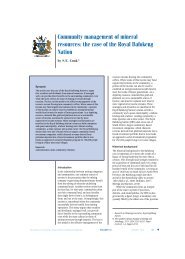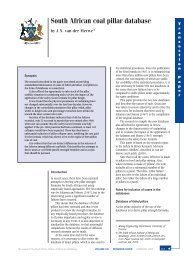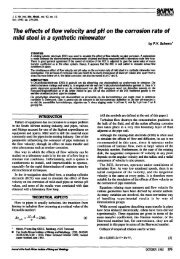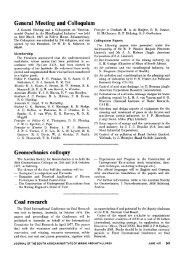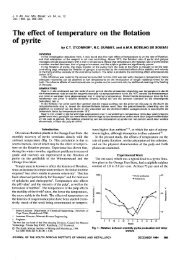The intensive cyanidation of gold-plant gravity concentrates - saimm
The intensive cyanidation of gold-plant gravity concentrates - saimm
The intensive cyanidation of gold-plant gravity concentrates - saimm
Create successful ePaper yourself
Turn your PDF publications into a flip-book with our unique Google optimized e-Paper software.
dissolution <strong>of</strong> <strong>gold</strong> and silver together with iron, copper,<br />
cobalt, nickel, and arsenic was investigated as a function<br />
<strong>of</strong> time so that the major cyanicides could be defined.<br />
<strong>The</strong> use <strong>of</strong> oxygen rather than air to aid the <strong>gold</strong> dissolution<br />
was also briefly considered.<br />
Concentrate samples <strong>of</strong> 2 kg each were leached with<br />
2 litres <strong>of</strong> cyanide solution in a covered 5-litre beaker.<br />
<strong>The</strong> pulp was well stirred by a large paddle-type stirrer,<br />
while the pulp was sparged at a constant flow-rate <strong>of</strong><br />
gas through a sintered-glass gas-distribution thimble.<br />
<strong>The</strong> reaction was carried out at ambient temperature,<br />
and, unless otherwise specified, the leaching times were<br />
confined to 20 hours. A micropump was employed to<br />
bleed the leach system continuously <strong>of</strong> filtered solution<br />
at a rate <strong>of</strong> 12,5 ml/h, and the solution was collected in<br />
a fraction collector for atomic-absorption analysis.<br />
After <strong>cyanidation</strong> the pulp was filtered, the filtrate<br />
being titrated for residual cyanide and the washed<br />
residue assayed for <strong>gold</strong> and silver. In certain instances,<br />
the leach residues were further separated into magnetic<br />
and non-magnetic fractions prior to analysis. Deionized<br />
water was used throughout the investigation.<br />
Figs. 1 and 2 illustrate the dissolution <strong>of</strong> <strong>gold</strong> and<br />
silver respectively from sample Wl (<strong>gold</strong> 6,3 kg/t),<br />
either oxygen or air being used to oxygenate the pulp.<br />
It can be clearly seen that oxygen has a markedly<br />
beneficial effect on the kinetics <strong>of</strong> both <strong>gold</strong> and silver<br />
leaching. After 20 hours, an extraction <strong>of</strong> 99,6 per cent<br />
<strong>of</strong> the <strong>gold</strong> and 99,4 per cent <strong>of</strong> the silver using oxygen<br />
can be compared with an extraction <strong>of</strong> 97,5 per cent <strong>of</strong><br />
the <strong>gold</strong> and 98 per cent <strong>of</strong> the silver using air (Table<br />
Ill).<br />
In a further test run in which the pH value was<br />
maintained at approximately 10,3 by the use <strong>of</strong> sulphuric<br />
acid (Test No. 5, Table Ill), a <strong>gold</strong> extraction <strong>of</strong><br />
93,2 per cent and a silver extraction <strong>of</strong> only 20 per cent<br />
were obtained. Such poor dissolution, together with the<br />
very high <strong>gold</strong> and silver contents <strong>of</strong> the magnetic<br />
fraction <strong>of</strong> the residue and the high soluble iron but<br />
low copper content <strong>of</strong>the leach liquor, strongly suggested<br />
the cementation <strong>of</strong> <strong>gold</strong>, silver, and even copper onto<br />
the metallic tramp iron present. This conclusion is<br />
supported by earlier findings in which iron powder was<br />
added to the leach pulp prior to <strong>cyanidation</strong> at pH 10,5.<br />
<strong>The</strong> deleterious effect <strong>of</strong> t,he iron powder was most<br />
marked when air rather than oxygen was used to oxygenate<br />
the pulp, indicating that the oxidizing potential <strong>of</strong><br />
the system plays a vital role in such a mechanism. <strong>The</strong><br />
reduction in the oxygen flow-rate from 180 cm3/min to<br />
20 cm3/min (Test No. 6, Table Ill) further substantiates<br />
the above suggested mechanism, whe,reagain a poor <strong>gold</strong><br />
extraction (87 per cent) was obtained together with<br />
abnormally high amounts <strong>of</strong> soluble iron in solution.<br />
Such poor recoveries can, however, be improved by the<br />
use <strong>of</strong> higher cyanide additions (Test No. 7, Table Ill)<br />
but result in an excessive consumption <strong>of</strong> cyanide.<br />
Alternatively, prolonged pre-aeration <strong>of</strong> the pulp (Test<br />
No. 8, Table Ill), producing an excessive iron hydroxide<br />
precipitate, resulted in a marked decrease in soluble<br />
iron. <strong>The</strong> resulting poor <strong>gold</strong> recovery (92 per cent) is not<br />
easily explained, but excessive adsorption <strong>of</strong> <strong>gold</strong> and<br />
silver by such a precipitate (very high positive zeta<br />
potential) is certainly suggested. <strong>The</strong> addition <strong>of</strong> lead in<br />
the form <strong>of</strong> lead nitrate prior to <strong>cyanidation</strong> appeared to<br />
have little or no effect on the <strong>gold</strong> dissolution under these<br />
specified conditions (compare Test Nos. 1 and 9, Table<br />
Ill). Likewise, small additions <strong>of</strong> lime had no noticeable<br />
effect on the <strong>gold</strong> dissolution (see later).<br />
An effort was made to approximate the contributions<br />
to the total cyanide consumption made by <strong>gold</strong>, silver,<br />
copper, and iron, neglecting the small contribution made<br />
by cobalt, nickel, and arsenic as well as that lost by<br />
oxidation. <strong>The</strong> following co-ordination numbers were<br />
assumed for the corresponding cyanide complexes: 6<br />
(iron), 3,6 (copper), 2 (<strong>gold</strong>), and 2 (silver). <strong>The</strong> solution<br />
concentration <strong>of</strong> the respective elements at the end <strong>of</strong><br />
each 20 hour leach (Table Ill) were then used in the<br />
calculation <strong>of</strong> the cyanide consumption. In most instances,<br />
the calculated consumption agreed fairly well<br />
with the observed consumption. Thus, for the best <strong>gold</strong><br />
extraction obtained (Test No. 7, Table Ill), it was<br />
shown that 63 per cent <strong>of</strong> the cyanide was consumed by<br />
copper, 19 per cent by <strong>gold</strong>, 15 per cent by iron, and 3<br />
per cent by silver. <strong>The</strong>se contributions can be compared<br />
with a very poor <strong>gold</strong> extraction (Test No. 6, Table Ill),<br />
where only 41 per cent <strong>of</strong> the cyanide was consumed by<br />
copper, 12 per cent by <strong>gold</strong>, 2 per cent by silver, and as<br />
much as 45 per cent by iron. This excessive cyanide<br />
consumption by iron is in many instances associated<br />
with poor <strong>gold</strong> and silver extractions.<br />
<strong>The</strong> leaching <strong>of</strong> a second sample <strong>of</strong> belt concentrate<br />
designated W2 (<strong>gold</strong> 22 kg/t) using variable oxygen<br />
flow-rates and cyanide additions (Test Nos. 1-3, Table<br />
IV) yielded very poor <strong>gold</strong> and silver extractions. Such<br />
poor extractions, together with slow(;1r <strong>gold</strong> dissolution<br />
rates and the observation that tJ:lere was sometimes a<br />
white crystalline precipl't at e n ~1;he pregnant liquor,<br />
suggested the saturation pf th liquor with some <strong>gold</strong><br />
.<br />
complex. <strong>The</strong> subsequent t<br />
..<br />
[an ly.sis <strong>of</strong> such a dried<br />
precipitate indicated the, fodnula NaAu(CN)2' It is<br />
interesting to note that, in tiios~ tests in which excessive<br />
additions <strong>of</strong> sodium cyariide were not made (Test No. 1,<br />
Table IV), the saturation dfthe pregnant liquor occurred<br />
at a <strong>gold</strong> concentration <strong>of</strong> approximately 13 g/l. However,<br />
when the addition <strong>of</strong> cyanide was excessive (Test<br />
No. 2, Table IV), only about 2 ill <strong>gold</strong> was found in<br />
solution. This suggests th~tthe so-lubility <strong>of</strong> the sodium<br />
aurocyanide complex decreases considerably with increasing<br />
cyanide concentration owing to a common ion<br />
effect. Such an effect ~a~ well be significant at the start<br />
<strong>of</strong> a reaction, when cyanide concentrations are relatively<br />
very high.<br />
In a demonstratioIi:that the above solubility effect<br />
slows down and even 'halts the dissolution <strong>of</strong> <strong>gold</strong> and<br />
silver, leaches were conducted with equimolar additions<br />
<strong>of</strong> potassium cyanide under similar conditions. (From the<br />
available information it appears that potassium aurocyanide<br />
is approximately 6 to 7 times more soluble than<br />
sodium aurocyanide.) It was immediately evident (Test<br />
No. 5, Table IV) that, under the prescribed experimental<br />
conditions, i.e., a liquid: solid ratio <strong>of</strong> 1:1 and 25 QC,<br />
the solubility <strong>of</strong> the <strong>gold</strong> cyanide complex plays a most<br />
significant role in the leaching <strong>of</strong> such rich <strong>concentrates</strong>.<br />
A <strong>gold</strong> recovery <strong>of</strong> 99,9 per cent, together with an iron<br />
JOURNAL OF THE SOUTH AFRICAN INSTITUTE OF MINING AND METALLURGY JANUARY 1978 151




